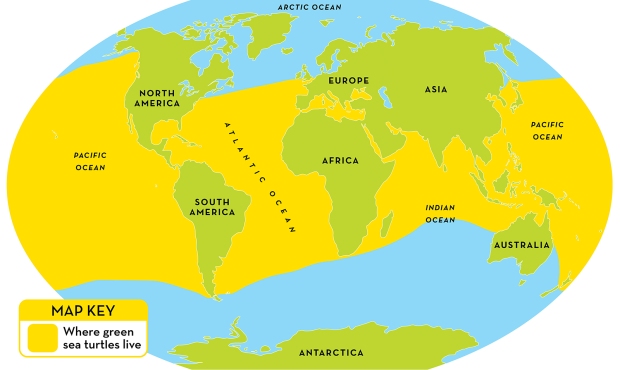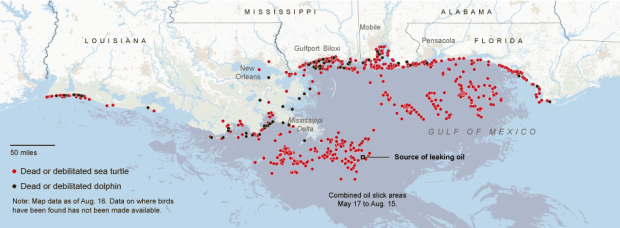Green Sea Turtle
Black Turtle (World Wildlife Fund for Nature, 2016)
Chelonia mydas (National Geographic, 2016)
Green Sea Turtle
Black Turtle (World Wildlife Fund for Nature, 2016)
Chelonia mydas (National Geographic, 2016)
 (Marchenko, 2012)
(Marchenko, 2012)
Green Sea turtles have a small head and single-clawed flippers. (U.S. Fish and Wildlife Service, 2015)
Weight ranges from 150-400 pounds, and size is about 3 to 4 feet in length. (World Wildlife Fund, 2016) Although there have been cases where the turtle has grown to be 5 feet in length and weigh up to 700 pounds. They live to be 80-100 years old. (National Geographic, 2016)
Their shells are normally heart-shaped. (U.S. Fish and Wildlife Service, 2015) Also the shells on green sea turtles are smooth and wide. (National Geographic, 2016)
The underside of the shell is a yellowish-white color. (National Wildlife Federation, 2016)
Green sea turtles have a greenish color to their skin, not their shell, which can be brown or olive depending on its habitat. (National Geographic, 2016) They also have a green tint to the fat on their body. (National Park Service, Accessed 2016)
Map of green sea turtle locations
The green sea turtle’s natural habitat is in mostly shallow waters inside reefs, bays and inlets. They are attracted to areas where there is a lot of seagrass and algae for them to feed on. (U.S. Fish and Wildlife Service, 2015) Location-wise they are found in Atlantic shores of North America and Pacific Coast of North America from Alaska to California. (National Park Service, Accessed 2016)
In 1978 green sea turtles were listed as endangered in breeding populations in Florida and the Pacific coast of Mexico. (NOAA Fisheries, 2016) In 2004 they were listed as endangered for the whole world. (Earth’s Endangered Creatures, 2006)
In large numbers, the green sea turtle can be found in Hawaii and Florida. In smaller numbers, they can be found in Puerto Rico, the U.S. Virgin Islands, Georgia, South Carolina, and North Carolina. (U.S. Fish and Wildlife Service, 2015)
Current locations of sea turtles vary around the world.  (National Geographic Society, 2015)
(National Geographic Society, 2015)
There are many protected areas for the green sea turtle around the world.
The green sea turtle population has declined due to culinary appeal starting in the late 1800’s. There was a lot of over-exploitation because people wanted to eat them. In the Gulf of Mexico there were a lot of green sea turtle fisheries, as well as in western Florida and the Florida Keys. (National Park Service, Accessed 2016)
Habitat loss and degradation makes it so the green sea turtle has no place to nest, which causes a decline in their population. Also when the sea grass beds are no longer intact, many green sea turtles have no food sources. (World Wildlife Fund for Nature, 2016)
Wildlife trade is a big factor in the population of green sea turtles because many of them are captured to sell as exotic pets and to restaurants that make dishes using exotic meats of many endangered species. (World Wildlife Fund for Nature, 2016)
Predators eating the eggs or meat lowers the population because the eggs are never able to hatch. (World Wildlife Fund for Nature, 2016)
Incidental capture (bycatch), which is when sea turtles are caught in large nets meant for fish. (World Wildlife Fund for Nature, 2016)
Climate change affects sea turtles because their ecosystems are disrupted, and because changes in water temperature can be harmful to their health. (World Wildlife Fund for Nature, 2016)
Pollution can cause sea turtles to ingest particles such as plastic bags that they can choke on. Also, other forms of pollution can change the pH of the ocean water and make it too acidic for them to live in. (World Wildlife Fund for Nature, 2016)
Increased amount of occurrences of fibropapillomas, a wild herpes-like virus that causes the turtles to grow tumors, may have been because of run-off from land or marine pollution that weakens the turtle’s immune system making them more susceptible to this disease. (World Wildlife Fund for Nature, 2016)
Ranging from the size of a grape to larger than a grapefruit, these tumors can impair vision, feeding, swimming, and can hinder the potential escape from predators. (Florida Fish and Wildlife Conservation Commission, 2016)
This is a map showing the effects of the BP oil spill on marine life.  (New York Times, 2010)
(New York Times, 2010)
With more green sea turtles, there will be healthier seagrass beds that ensure many species will not also become endangered. They would also increase the productivity of the seagrass beds. (Wilson, Accessed 2016)
People may be able to one day consume green sea turtle without the major risk of it becoming extinct.
Less risk of species diversity loss in marine ecosystems.
Sand dunes would contain more nutrients because of the sea turtle egg nests that they contain over the summer, and there would be less erosion of these sand dunes.
Green sea turtles are one of the few animals that eat sea grass. Seagrass is essentially like the grass we have on our lawns, but on the seafloor. In order for it to stay healthy for organisms such as fish, shellfish and crustaceans, to be able to breed and develop on these seagrass beds, the blades need to be kept short and healthy. Because the population of green sea turtles has been declining, so have seagrass beds. This can lead to a loss in biodiversity in marine life, and potentially can harm humans due to the lower levels of species they can harvest for consumption. (Sea Turtle Conservancy, 2015)
Sea turtles lay between 3 and 7 nests during their summer nesting season. Each nest contains around 100 eggs. Although not every egg in a nest will hatch, the eggs still play an important role in providing nutrients to the vegetation in the dunes. Even leftover shells from sea turtles that have already hatched can give the dunes nutrients. With stronger vegetation that have strong root systems, the sand is able to be held in place and protect the beach from erosion. (Sea Turtle Conservancy, 2015)
“Fibropapillomatosis and Its Effect on Green Turtles.” Florida Fish and Wildlife Conservation Commission. State of Florida, 2016. Web. 19 Apr. 2016. <http://myfwc.com/research/wildlife/sea-turtles/threats/fibropapillomatosis/>.
“Green Sea Turtle.” National Geographic. National Geographic Society, 2016. Web. 20 Apr. 2016. <http://animals.nationalgeographic.com/animals/reptiles/green-turtle/>.
“Green Sea Turtle.” National Geographic Kids. National Geographic Society, 2015. Web. 20 Apr. 2016. <http://kids.nationalgeographic.com/animals/green-sea-turtle/#green-sea-turtle-closeup-underwater.jpg>.
“The Green Sea Turtle.” National Park Service. National Park Service, n.d. Web. 21 Apr. 2016. <https://www.nps.gov/pais/learn/nature/green.htm>.
“Green Sea Turtle.” National Wildlife Federation. National Wildlife Federation, 2016. Web. 21 Apr. 2016. <https://www.nwf.org/Wildlife/Wildlife-Library/Amphibians-Reptiles-and-Fish/Sea-Turtles/Green-Sea-Turtle.aspx>.
“Green Sea Turtle (Chelonia mydas).” U.S. Fish and Wildlife Service. U.S. Fish and Wildlife Service, 21 May 2015. Web. 19 Apr. 2016. <http://www.fws.gov/northflorida/seaturtles/turtle%20factsheets/green-sea-turtle.htm>.
“Green Turtle.” WWF. World Wildlife Fund for Nature, 2016. Web. 20 Apr. 2016. <http://wwf.panda.org/what_we_do/endangered_species/marine_turtles/green_turtle/>.
“Green Turtle.” WWF. World Wildlife Fund, 2016. Web. 18 Apr. 2016. <http://www.worldwildlife.org/species/green-turtle>.
“Green Turtle (Chelonia mydas).” NOAA Fisheries. National Oceanic and Atmospheric Administration Fisheries, 6 Apr. 2016. Web. 20 Apr. 2016. <http://www.nmfs.noaa.gov/pr/species/turtles/green.html>.
“Information About Sea Turtles: Why We Care?” Sea Turtle Conservancy. Sea Turtle Conservancy, 2015. Web. 19 Apr. 2016. <http://www.conserveturtles.org/seaturtleinformation.php?page=whycareaboutseaturtles>.
“The IUCN Red List of Threatened Species.” IUCN Red List. International Union for Conservation of Nature and Natural Resources, n.d. Web. 20 Apr. 2016. <http://maps.iucnredlist.org/map.html?id=4615>.
Marchenko, Dmitri. “Green Sea Turtle, Red Sea.” National Geographic. National Geographic Society, 21 Sept. 2012. Web. 19 Apr. 2016. <http://photography.nationalgeographic.com/photography/photo-of-the-day/green-turtle-egypt/>.
Nuwer, Rachel. “Pollution from Hawaii Is Giving Sea Turtles Gross, Deadly Tumors.” Smithsonian.com. Smithsonian, 2 Oct. 2014. Web. 19 Apr. 2016. <http://www.smithsonianmag.com/smart-news/pollution-hawaiis-farms-and-cities-causing-sea-turtles-get-deadly-tumors-180952912/?no-ist>.
Park, Haeyoun, et al. “The Oil Spill’s Effect on Wildlife.” The New York Times. N.p., 2010. Web. 21 Apr. 2016. <http://www.nytimes.com/interactive/2010/04/28/us/20100428-spill-map.html>.
R, Glen C. “Green Sea Turtle Facts.” Earth’s Endangered Creatures. Earth’s Endangered Creatures, 1 Jan. 2006. Web. 20 Apr. 2016. <http://www.earthsendangered.com/profile.asp?gr=R&view=c&ID=9&sp=821>.
“Recovery Plan for U.S. Pacific Populations of the Green Turtle (Chelonia mydas).” NOAA Fisheries. National Oceanic and Atmospheric Administration Fisheries, 1998. Web. 20 Apr. 2016. <http://www.nmfs.noaa.gov/pr/pdfs/recovery/turtle_green_pacific.pdf>.
“Submission Guildlines.” VLDB 2015. N.p., n.d. Web. 20 Apr. 2016. <http://www.vldb.org/2015/submission-guidelines.html>.
Wilson, E. G., et al. “Why Healthy Oceans Need Sea Turtles.” Oceana: Protecting the World’s Oceans. Oceana, n.d. Web. 21 Apr. 2016. <http://oceana.org/sites/default/files/reports/Why_Healthy_Oceans_Need_Sea_Turtles.pdf>.